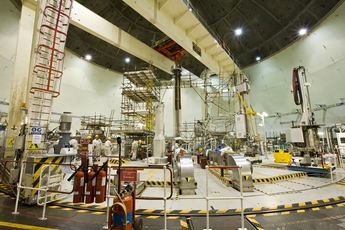A £20 million tool, built by Areva to remove close to a thousand metal breeder rods from the Dounreay Fast Reactor has been installed. Removal of the rods is due to begin in early 2013.

The custom-built retrieval arm will spend three years inside the reactor vessel, carefully cutting free 977 metal rods standing vertically in a hexagonal rack around the near-empty core. Each rod will be cut free from its mounting and transferred to a waiting basket, ready to be lifted through the roof of the reactor.
“The reactor was a one-off design and so is the tool we need to take out the breeder rods,” said Alex Potts, the engineer in charge of the project at Dounreay Site Restoration Ltd.
“It’s too toxic in there for anyone to do the job manually – the radiation levels are still very high and the residual traces of liquid metal coolant add to the hazard – so we need a tool capable of doing the job by remote control. It’s a pretty sophisticated version of a Swiss army knife the team came up with.”
France’s Framatome (now Areva) designed and built the retrieval arm. It has 16 detachable tool-bits that cost £100,000 each and weigh between 37 and 93kg. They cover the range of equipment needed to retrieve the metal rods including grabs, manipulators, milling and cutting.
Up to three tool-bits will be in use at any one time and can be replaced by another three carried in a special toolbox without needing to remove the tool itself from the reactor.
Special radiation-proof cameras and spotlights will guide operators working around the clock in a control room 20 feet above in the hall of the containment sphere.
The DFR shut down in 1977 after almost 20 years of experiments and is now being decommissioned. Some 2000 rods surrounded the core when the reactor operated between 1959 and 1977. Over half were removed after it shutdown but 977 were left in place. Some had become jammed and a shortage of storage space at the site delayed their removal.
Related ArticlesConstruction vs communication




